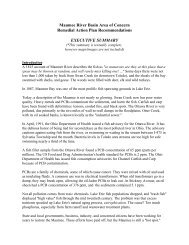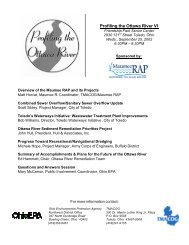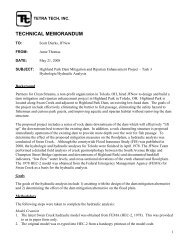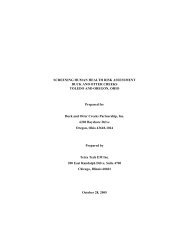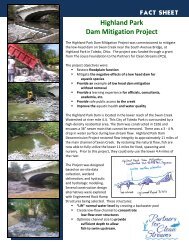Complete report - Partners for Clean Streams
Complete report - Partners for Clean Streams
Complete report - Partners for Clean Streams
Create successful ePaper yourself
Turn your PDF publications into a flip-book with our unique Google optimized e-Paper software.
area (as recommended in the Point Place Flow Monitoring and Evaluation Study<br />
(January 1995)) was to convert the preliminary diagnosis into firm conclusions as to<br />
the presence, location and magnitude of the inflow and infiltration. Systematic<br />
methods were used to locate defects in the manholes and sewers, sources of<br />
infiltration and inflow, and deficiencies in the sewer system, including smoke testing,<br />
manhole inspections, internal television inspection, flow isolations, and dye testing.<br />
Results of the survey confirmed the presence and location of several potential<br />
sources of inflow and infiltration in 16 basins, with moderate and severe infiltration and<br />
inflow related to rainfall. For each potential source located, an estimated volume of<br />
infiltration and inflow was attributed based on the condition of the source and the<br />
potential source was evaluated to determine whether the source could be reduced or<br />
eliminated. The cost of rehabilitation and removal was compared to the cost of relief<br />
or replacement sewers required <strong>for</strong> transport and treatment.<br />
Survey results located or identified the following: broken pipe, cracked pipe, offset<br />
joint, open joint, root intrusion, blockages, and connections with storm sewers.<br />
Recommended projects were divided into two phases. The projects recommended in<br />
Phase I will reduce some major deficiencies and significantly reduce the sanitary<br />
sewer overflows in the Point Place sanitary sewer system. Phase 1 projects include:<br />
- Manhattan Boulevard Pump Station<br />
- Eliminate Cross-Connections with Storm Sewers<br />
- <strong>Clean</strong> Sewers<br />
- Replace Deficient Sanitary Sewer<br />
After Phase I projects were completed, the system was to be evaluated as part of<br />
project certification. After project certification, Phase II projects will be reevaluated.<br />
Phase II projects will eliminate the remaining sewage sanitary overflows by<br />
transporting the excess sewage to an equalization basin or directly to the treatment<br />
plant if capacity is available. Phase II would occur between 2002-2006. Currently<br />
recommended Phase II projects include:<br />
- Eliminate 290 th Street Sanitary Relief Pump Station<br />
- Eliminate 145 th Street Pump Station<br />
- Rehabilitate the 129 th Street Lift Station<br />
- Construct relief sewers in Edgewater Drive<br />
- Construct an Equalization Basin at the wastewater treatment plant<br />
Lead Organization:<br />
City of Toledo<br />
Combined Sewer Overflow Impact Study<br />
1997<br />
Description:<br />
This Impact Study recommended the following projects to further abate Toledo’s CSO<br />
impacts to the Ottawa River:<br />
- Partial separation of Lagrange Area - scheduled <strong>for</strong> completion 2000.<br />
- Partial separation of Monroe South area (in 2002)<br />
- Ottawa River CSO storage/treatment facility (Phase 1 - Lockwood, Ayers,<br />
and Monroe – in 2002)<br />
- Ottawa River CSO storage/treatment facility (Phase 2 - Lagrange,<br />
Windermere and Devilbiss - in 2004)<br />
Activities and Accomplishments<br />
in the Maumee Area of Concern<br />
179<br />
Issue 6: Combined<br />
Sewer Overflows



